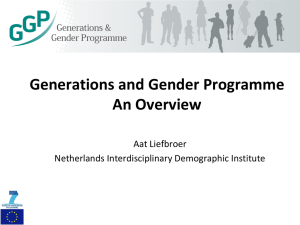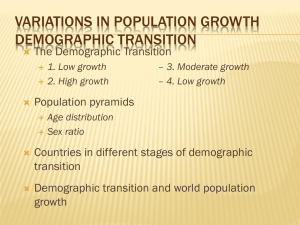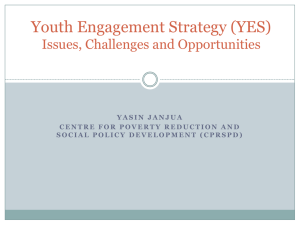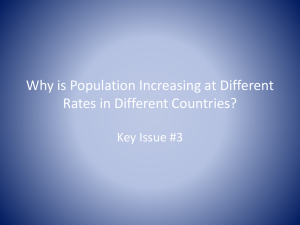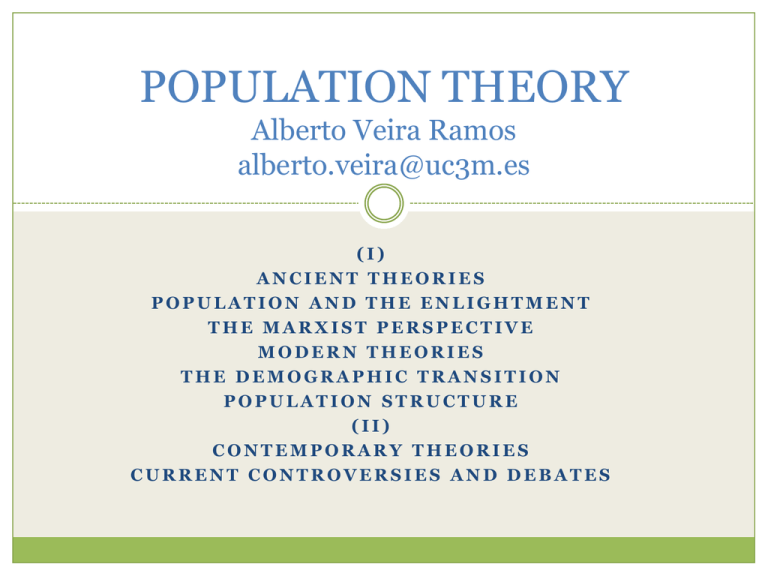
POPULATION THEORY
Alberto Veira Ramos
alberto.veira@uc3m.es
(I)
ANCIENT THEORIES
POPULATION AND THE ENLIGHTMENT
THE MARXIST PERSPECTIVE
MODERN THEORIES
THE DEMOGRAPHIC TRANSITION
POPULATION STRUCTURE
(II)
CONTEMPORARY THEORIES
CURRENT CONTROVERSIES AND DEBATES
HANDBOOK
A great deal of the
materials presented in
this course are from the
book of Professor Jesús
Javier Sánchez
Barricarte
“El Crecimiento de la
Población Mundial”
POPULATION AND DEVELOPMENT
What is the effect of population
growth on economic
development?
(pessimistic perspectives)
Kingsley Davis, A. Coale & Hoover, The World Bank
POPULATION AND DEVELOPMENT
At the World conference on population at Bucharest in
1974 two schools of thought collided:
Neoclassic economists
In favor of slowing down population growth.
Poverty is caused by Rapid Population Growth (RPG)
Marxist perspective
Demographic growth is independent from economic
development
The causes of poverty are economic exploitation and political
domination
Such debate takes place under the context of the Cold
War and an unprecedented demographic growth in third
world countries
Kingsley Davis (1908-1997)
Reputed sociologist
Helped to establish the
department of
demography of the
University of California at
Berkeley.
President of the PAA
Represented the USA
before the UNPC
Kingsley Davis (1908-1997)
K. Davis popularized the terms:
“population
explosion”
“zero population growth”
Stood against sending food to poor countries
because it would only make poor populations
larger in size and entirely dependent on charity for
their subsistence
Argued that “excessive reproduction” (more than
four children per woman) should be consider “a
crime”
Kingsley Davis (1908-1997)
Argued that rapid population growth (RPG) makes
economic development more difficult:
High dependency ratios cause by a large infant population
deters societies from investing its resources elsewhere
High fertility makes difficult for women to enter and stay in
the labor market
Parents of large families cannot provide their children with
adequate clothing, health care and proper education
RPG contributes to increase dramatically the number of
young people looking for a job, which leads to high youth
unemployment and ultimately to political unrest
Urbanization will be affected by massive migration from
rural areas of high fertility, creating a negative environment
for social stability and economic development
Kingsley Davis (1908-1997)
Proposed several drastic measures to avoid RPG in
developing countries:
Increase the legal age of marriage
Establish a tax for marriage and child bearing
Mandatory sterilization after the 5th birth
Pay money to those who sterilize voluntarily
Governments should pay for abortions
Reduce maternity aid
Ansley Coale (1917-2002) and Edgar M. Hoover
Ansley Coale and Edgar M.
Hoover were co-authors of the
book:
Population Growth and Economic
Development in Low-Income
Countries (1958)
Used data from India and
Mexico
Provided the theoretical
foundations for birth control
policies in developing countries
financed by the U.S.
Government and the United
Nations
Ansley Coale (1917-2002) and Edgar M. Hoover
Economic development requires investment of
capital.
Capital is the wealth and the goods…
…used to produce more goods and increase the existing wealth
Not the wealth and goods used for immediate consumption!
To escape poverty,
growth rate of capital must be higher than demographic
growth rate
Ansley Coale (1917-2002) and Edgar M. Hoover
Populations with high dependency ratios can devote
smaller amounts of capital to investment, which is
negative for economic development
The extraordinary increase of the number of children
makes saving more difficult for families and governments
Families must spend on food, clothing and school books
Governments must spend resources on basics like health care and
education for larger number of children
Governments have fewer resources to spend on infrastructures
such as irrigation systems, roads, energy plants, etc.
Otherwise, inadequate nourishment and health care
would cause the number and frequency of diseases
Ansley Coale (1917-2002) and Edgar M. Hoover
Rapid Population Growth (RPG)…
Makes unemployment to raise and salaries to go down
Contributes to increase the prices of certain goods and
services
Makes Governments of developing nations more dependent
on foreign aid, which leads to increases on national debts,
thus widening the gap between developed and developing
societies
Worsens the economic situation of poor people
Increases the probability of social unrest and revolts
Ansley Coale (1917-2002) and Edgar M. Hoover
When populations grow faster than capital
accumulation (investment) they will find
themselves trapped inside a Malthusian vicious
circle of poverty:
Economic growth will make possible to feed more mouths,
but not suffice to escape from poverty and misery
To escape poverty, capital accumulation must grow
faster than population
The World Bank
The World Bank published in 1984 a study in which it is
argued that RPG slows down economic growth:
Diverts resources into consumption rather than into more
productive investment
It complicates making the necessary investments to improve “the
quality of the population”
Threatens the precarious equilibrium between population and
natural resources
Makes more difficult the adjustments and transformations that
must accompany social and economic changes
https://openknowledge.worldbank.org/bitstream/handle/10986/
5967/WDR%201984%20-%20English.pdf?sequence=1
The World Bank
Link to the full report:
https://openknowledge.worldbank.org/bitstream/handle/109
86/5967/WDR%201984%20-%20English.pdf?sequence=1
Page 106 of the report states that:
“Experience has shown that as development progresses
fertility falls. Yet, because current rates of population growth
are so much greater in the developing world than they were at
comparable income levels in today's developed countries,
many developing countries cannot afford to wait for fertility to
decline spontaneously.”
The World Bank
The world Bank also acknowledges that under certain
circumstances a moderate population growth can indeed
be beneficial for development
It stimulates demand, technological innovation and reduces
investment risks
A moderate increase on the size of working population along with
adequate investments on education can improve the productivity
of the working population
In countries where population is very sparsely distributed,
demographic growth (higher population density) may be
beneficial because it makes infrastructure investment more
feasible and less risky
The World Bank
The world Bank study acknowledges that
Demographic growth is not the major cause of poverty
in Third World countries
Many countries have managed to increase their income
per capita even under RPG
However, The World Bank recommends that
Governments in developing countries should
indeed implement policies for population control
to slow down demographic growth
POPULATION AND DEVELOPMENT
Link to the website of University of Princeton on
Population Control
https://www.princeton.edu/~achaney/tmve/wiki100k/docs/Populat
ion_control.html
“Human population control is the practice of artificially altering
the rate of growth of a human population”
Video Disney 1968
http://www.youtube.com/watch?v=t2DkiceqmzU
Population control on media nowadays
http://www.bbc.com/news/magazine-24303537
Population in the world nowadays
http://www.educaplus.org/geografia/mun_piramides.html
POPULATION AND THE ENVIRONMENT
What is the effect of population
growth on the environment?
(pessimistic perspectives)
Paul y Anne Ehrlich, Lester Brown, Paul Lovelock,
Eric Pianka, Garret Harding
POPULATION AND THE ENVIRONMENT
Human population growth represents a danger for the
environment, the planet and humans themselves:
Paul and Anne Ehrlich
Zero demographic growth
The Eco-economy
Lester Brown
James Lovelock
“Gaia”
Eric Pianka
Eco-economy and Natural Capital
The Book of life
Garret Hardin
The tragedy of the commons
The lifeboat theory
Paul and Anne Ehrlich
Paul Ehrlich (1932-)
American entomologist and
Professor at Stanford
University
Funded the organization
“Zero Population Growth”
(1968)
The Population Bomb (1968)
Anne H. Ehrlich (1933-),
American biologist and
Professor at Stanford
University
The Population Explosion
(1990)
Paul y Anne Ehrlich
In the book “The Population Bomb” (1968), Paul R. Ehrlich
affirmed that:
The battle to feed all humans is lost: During the 80’s and 90’s
hundreds of thousands will starve to death
Aid programs will be useful only to delay the catastrophe
Human population is spreading all over the planet like a cancer
Technological improvements may increase food production for some
time but at the price of spoiling the environment
The problem can only be solved by decisive policies of population
control
Changing values to ensure voluntary self-control
Tax all products related to child rearing
Reward those who agree to sterilize before having a second child
Coercive measures are also legitimate
Paul y Anne Ehrlich
In the book “The demographic explosion” (1990) ,
Anne Ehrlich considers that the most important
challenges humanity faces are:
The rapid depletion of the nonrenewable resources of the
planet
The global deterioration of the environment, which will
provoke shortages on drinking water supplies
Risk of wars for the access to increasingly scarce
resources
There is a need to convince reluctant politicians that
classic economy must be replaced by “eco-economy”
Lester Russell Brown (1934-)
American, MS in
Agricultural economy
Developed the concepts
Eco-economy
Natural Capital
In 1974, along with the
Rockefeller Foundation
he created the World
Watch Institute
http://www.worldwatch.org/
Lester Russell Brown (1934-)
Free market economy is more efficient than centrally
planned economy but it does not account fully for all
the costs of producing the goods we want because the
consequences of environmental degradation are not
contemplated
The eco-economy considers fertile lands, forest, fishing
banks, etc., as if they were Natural Capital
Therefore, degradation for the environment should be
regarded as a decapitalization problem, thus,
impoverishment
Lester Russell Brown (1934-)
Lester R. Brown considers that population growth represents
a serious problem because it provokes
Deforestation of the planet
Depletion of fishing banks
Rising levels of carbon dioxide
Erosion of the soil
Scarcity of drinking water
Raise of temperatures
Extinction of species
He supports the diffusion of population control programs
Sterilization
Family planning
He supports the one-child policy of the Chinese government
Eric R. Pianka (1939-)
American biologist
Professor of Zoology at
Texas University
The American Academy
of Sciences named him
“Scientist of the year” in
2006
The Book of Life
Evolutionary Ecology
(1983)
Eric R. Pianka (1939-)
Humans are destroying “The Book of Life”
Humans are destroying the ecological niches and
environments even before we had the chance to study them
fully
Denounces our economic model as anthropocentric and
proclaims the value of biodiversity
Affirmed that population growth is disastrous for life on
Earth because of the pollution we cause
“Every time you breath, take a shower or pull the flush, every time
you drive your car or buy anything, you are contributing to spoil and
contaminate the planet”
He supports policies for population control and estimates
that up to 90% of human population should be reduced to
reach tolerable figures for the planet
James E. Lovelock (1919-)
English scientist
Works for NASA
Earth, Gaia, is a living
organism
All living creatures and
also nonliving things are
part of that organism
“On aggregate, human
beings have grown enough
in numbers to be regarded
as a serious planetary
disease”
“Gaia suffers Primatemia
diseminada, a plague of
people”
Garrett J. Hardin (1915-2003)
American biologist
Professor of Human
Ecology at California
University (Santa
Bárbara)
Author of
The tragedy of the
commons (1968)
Living within limits
(1993) lifeboat theory
Garrett J. Hardin (1915-2003)
In economics, Adam Smith, developed the concept of the
“invisible hand”, the idea that when individuals seek their
own self-interest, the general interest is also attained
In “The tragedy of the commons” (1968), Hardin explains
how a village of cattle owners would function if property of
the cattle is private but pastures are of common property
and its grass is shared by all the community
Free access to resources brings about the ruin for
everybody
Garrett J. Hardin (1915-2003)
In “The tragedy of the commons” (1968), Hardin
supports the idea that humans live in a finite world
which can give support only to a limited number of
people
Is it correct to let people decide freely about the
number of children they may have?
Regarding human reproduction, the “invisible
hand” does not work in favor of the common good
Garrett J. Hardin (1915-2003)
Exploring new ethics for survival:
living in a lifeboat (1974)
lifeboat ethics (1974)
Hardin critisizes sending food and medicines to the third
world countries
It makes their populations continue growing and
therefore violating what he considers the first
commandment of modern Ecology:
“one shall not exceed the carrying capacity”.
Each country should bear the burdens of their own
reproductive behavior
Hardin estimated the optimal size for human populations on
100 million people
Garrett J. Hardin (1915-2003)
In “Living within the limits” (1993), Hardin
advocates again in favor of his “lifeboat theory”:
Planet Earth is like a spaceship or a lifeboat which carries
a limited amount of supplies
Inside this boat, humans are to be regarded as a burden
who are exhausting the supplies
Harding does not pay consideration to the fact that
humans, thanks to our technology, may indeed be
capable of generating new resources or “expand” the size
of the boat
Garrett J. Hardin (1915-2003)
Hardin considers people should not be free to decide
how many children to have…
… if parents were the only responsible for the
consequences…
However, nowadays, many societies are engaged on
attaining goals like a proper Welfare State, where
many costs of having children are transferred from
families to the State
Garrett J. Hardin (1915-2003)
Hardin supported drastic measures to reduce
population growth:
Limit the number of children a couple may have
Sponsor abortion
Euthanasia to newborns with severe physical problems
Justifies infanticide within its proper historical context
He even developed ideas close to Eugenics and Social
Darwinism:
People who go to university is more intelligent. It would be
better to have them having children and not the less clever
ones
Garrett J. Hardin (1915-2003)
Hardin didn’t realize that what was happening was
something quite different than what he was fearing:
Close to half the population hardly reaches
generational replacement.
Couples have fewer children because most of the costs
will have to be born by themselves with little help from
governments
However, the future benefits of a child, after becoming
an adult, will be profited by the whole society
An inconvenient truth (2006)
Authors:
Davis Guggenheim(1963-)
Al Gore (1938-)
Vice President of the United
States (1993-2001)
Main ideas
Create awareness of the
consequences of climate change
Argue climate change is caused by
human activity
Albert Gore awards
Prize Prince of Asturias for
International cooperation (2007)
Nobel Prize (2007), shared with the
Intergovernmental Panel on Climate
Change (IPCC) of United Nations
http://www.ipcc.ch/
An inconvenient truth (2006)
One study from the Nielsen Company Oxford
University about the impact of the documentary
conducted in 47 countries in 2007 revealed that:
66% of viewers admitted their view on climate warming had
changed
89% declared to be more concerned about the importance of
the problem
74% declared have changed some of their habits after having
watched the documentary
POPULATION CONTROL AND POLITICS
Many institutions have been in favor of the
implementation of population control policies
United Nations
The World Bank
Private Foundations
National governments (USA, China, amongst others)
POPULATION CONTROL AND POLITICS
UNFPA http://www.unfpa.org/public/home
Funded in 1969, a year after “The Population Bomb” was published
Amongst its tasks there was the coordination of efforts to slow down
population growth
It backed China’s one child policy and sponsored Vietnam’s 2 child
only policy
Gets funding from various private foundations which are in favor of
slowing down demographic growth
UNICEF http://www.unicef.org/
On 1966 there was a big conflict between members of the directive
board who disagreed on weather this organization should sponsor or
not policies for population control
UNESCO http://en.unesco.org/
Its first director was Julian Sorell Huxley, a member of the British
Eugenics Society, who favored policies for population control
POPULATION CONTROL AND POLITICS
Julian Sorell Huxley:
"…unless [civilised societies] invent and enforce adequate measures
for regulating human reproduction, for controlling the quantity of
population, and at least preventing the deterioration of quality of
racial stock, they are doomed to decay…“ (Huxley, Julian. 1926.
Essays in Popular Science. London: Chatto & Windus, ix.)
Opposed Catholic and Communist views on population control
In “The Crowded World” he predicted 6 billion people for 2.000 and
warned consequences could be catastrophic
POPULATION CONTROL AND POLITICS
The World Bank
On numerous occasions the help provided by this institution
was given under the condition that receiving governments
should implement policies of population control
Several of its presidents had quite strong views on this matter
Robert McNamara: Rapid population growth is a major obstacle
for economic growth and for wellbeing amongst members […]
Demographic control is an area where The World Bank must take
initiatives
Alden Clausen: Some countries will not be able to develop if they
do not stop soon their demographic growth
Baber Conable: It is imperative that developing countries renew
their efforts to stop demographic growth
POPULATION CONTROL AND POLITICS
The U.S. Government
President Eisenhower appointed an expert group chaired by David Rockefeller to
evaluate the prospects for the expansion of American Industry (1952):
RPG could be a threat for American interests because deprives America from the
access to necessary resources and increases the chances of revolutions
President Nixon appointed Henry Kissinger, chair of the NSA, to create a report on
how population growth could affect American interests (1970):
The “Kissinger Report” alerted about massive migration to cities and developed
countries and increasing social unrest which may turn into support of
revolutionary movements
A more populated third world may limit the access of America to its resources
Favored the implementation of policies for population control (“family planning”)
International Aid Act (1978)
International aid should go to nations that agree on implementing policies for
population control
President Ronald Reagan
Influenced by the work of Julian Simon, he changed the American policy on population control
POPULATION CONTROL AND POLITICS
Numerous foundations and private organizations active in favor
of population control are funded by very rich and influential people
Ford, Rockefeller, Airlie, Kellog, General Service, Andrew Mellon, Sunnen,
Tinker, John D. y Catherine T. MacArthur, Public Welfare, William y Flora
Hewlett, David y Lucile Packard, Bergstrom, Bill y Melinda Gates…
The Rockefeller foundation finances the department of Demography of
Princeton University where Kingsley Davis, Frank Notestein and Ansley J.
Coale carried out their academic activity
Rockefeller III finances The Population Council, which publishes
The Ford Foundation financed the publication of
“Studies in Family Planning”
“Population and Development Review”
“Demography”
The USAID financed the journal
“International Family Planning Perspectives”
POPULATION CONTROL AND POLITICS
The demographer Susan C. Watkins
pointed out that many scientific articles
published on the journal “Demography”
during the second half of the 1960’s are
“obsessively” oriented to assert the idea
that is was imperative to slow population
growth in the third world
EUGENICS
Francis Galton (1822-1911) founding father of eugenics
Eugenic selection vs natural selection
What mother nature does blindly, humans can do
consciously
Positive eugenics
Preserve genetic legacy of superior individuals
Ban mixed marriages
Stimulate their reproduction
Negative eugenics
Prevent inferior individuals from reproducing
Prevent migration
Sterilization
EUGENICS
Eugenics became very popular among elites of American Society
James J. Hill (Railroad magnate)
John D. Rockefeller (Oil magnate)
Andrew Carnegie (Steel magnate)
Margaret Sanger (Founder of IPPF, International Planned Parenthood
Foundation)
American Weekly Magazine (1934)
Couples should need maternity permit from governments
Permits will be granted if couples have adequate economic resources and had no
hereditary diseases
No permits should be issued to have more than one child
The retarded, criminals and those having had hereditary diseases should be
sterilized
Eugenics in Europe
Germany: during the 1930’s about 320.000 people were sterilized
Between 1934 and 1975 up to 63.000 and 48.000 people were sterilized in
Sweden and Norway (mostly women)
POLICIES ON BIRTH CONTROL
India
Since 1959 compensations are offered to those who agree to be sterilized
In 1975, the Indira Gandhi Government decreed a temporary “emergency”
suspension of certain civil rights to force more sterilizations including
measures such as:
Obligatory sterilization of couples with at least 4 children
A certificate of sterilization is required for certain government permits,
credits or subsides to buy fertilizers for the land
Schooling for children whose parents have more than 3 children is denied
Housing provisions were approved for those who accept being sterilized
Illiterate people were sterilized without knowing about it after visiting the
local HMO
Because of these aggressive policies, increasing numbers of Indians stopped
going to clinics and health care centers. Finally, due to numerous revolts
against birth control policies, the government fell in 1977
POLICIES ON BIRTH CONTROL
India
The new government continued sponsoring birth control policies but restricting them
to women who voluntarily accept it
Individual incentives for doctors who convince people to be sterilized
Collective incentives to convince communities (villages) to accept sterilization in
exchange for some public works
Extensive use of not entirely safe methods of sterilization (mainly on women) such as:
Net-En,
Norplant (58% of women suffered severe secondary effects: thrombosis, hepatitis,
arthritis and in some regions implanted only on Muslim women)
Quinacrine, declared illegal by WHO
All these policies had the support of international institutions
The World Bank financed the Norplant campaign
The IFFH (International Federation of Family Health) financed the Quinacrine
The IPPF (International Planned Parenthood Federation)
Western Governments required as a condition for sending food aid the
implementation of birth control policies
POLICIES ON BIRTH CONTROL
Bangladesh:
Norplant implanted on women in exchange for cereals and a dress
Vietnam: The Two Child Policy
Parents who have more than 2 children:
Are obliged to pay for health care and education of the 3rd child
Are expulsed from the Communist Party
May have their land confiscated or obliged to abort
Philippines: The 1995 (Bh-GC) hormone scandal
The Supreme Court, declared proved that this vaccine against tetanus
contained one hormone that caused abortions and sterilization
The campaign was sponsored by UNICEF and denounced by the Philippine
League of Catholic Women
Further investigation proved that the vaccination campaign had already
reached 3 million women in the Philippines and had also been administrated
in at least other 4 countries
POLICIES ON BIRTH CONTROL
Peru
In 1995 the Fujimmori Government developed a campaign for sterilization
partly funded by USAID and UNFPA
In 2002, after leaving power, it was known that 90% of people sterilized
were not told about the irreversibility of the operation
Puerto Rico
Sterilization of one third of fertile women thanks to the support of the IPPF.
Most women did not know the operation was irreversible
Colombia
Sterilization of women thanks to the support of the IPPF.
Most women did not know the operation was irreversible
Mexico
Indigenous communities accept sterilization in exchange for public works,
housing, clothing, or health care centers
Promised were not always kept
POLICIES ON BIRTH CONTROL
China: The One Child Policy
After the 1949 revolution Mao Zhedong opposed population
control policies: “Of all things of this world, people are the
most valuable […] Under the leadership of the Communist
Party, any miracle can become real”
In 1953, Party officials were alarmed because of the difficulties
to feed all the population
In 1956, a year of bad crops, Mao urged officials from highly
dense populated areas to develop policies for birth control
The idea that fertility is not to be regarded as something that
should be kept on the private domain but rather as a matter of
concern for the State began to take shape
In 1979 the “one child policy” was adopted
POLICIES ON BIRTH CONTROL
POLICIES ON BIRTH CONTROL
China: legal reforms favoring birth control
Chinese Constitution: All married couples are obliged to abide
to birth control policies
It is illegal to have children if the woman is not married
Legal age of marriage is established at 22 for men and 20 for
women
Obligatory sterilization for couples who at the moment had
had already two or more children
Women who had already one child should implant a IUD
Couples with a record of any hereditary disease are forbidden
to have children
Civil servants are to conduct regular pregnancy tests on all
married women
POLICIES ON BIRTH CONTROL
China: sanctions against those not abiding the laws
on birth control
Lose the job or possibility of promotion
Expulsion from the Communist Party
Administrative sanctions, fines
Single mothers must pay fines up to ten times the salary of one
year
Those who can’t pay the fines will have their properties
confiscated (land, cattle, flat…)
Forced abortions and sterilizations
POLICIES ON BIRTH CONTROL
Some international organizations have denounced such practices
Human Rights Watch
International Amnesty
Freedom House
The Chinese Government has always stick firmly to the idea that:
“Only coercive measures can be effective to alleviate the problems
caused by the demographic explosion” Economic Daily January 24th
1989, quoting a senior government official from the Ministry of
Agriculture
UNINTENDED CONSEQUENCES
OF BIRTH CONTROL POLICIES
Patriarchal values…
Traditional preference for a male son, particularly in Asia
In India it is the son the responsible for lighting the funerary
pile of the parents and pray for their souls
In societies were women are discriminated, sons are more
likely to reach a position (income level, land property) from
which they can help their parents during old age
The dowry can be a burden for low-income families
In certain cultures, the daughter is considered as member of
the husband’s family after marriage
…and aggressive birth control policies may lead to
female infanticide and feticide
UNINTENDED CONSEQUENCES
OF BIRTH CONTROL POLICIES
A biologically normal
sex ratio is one of 105
to 107 men per 100
women at birth
Higher values indicate a
bias against women
UNINTENDED CONSEQUENCES
OF BIRTH CONTROL POLICIES
UNINTENDED CONSEQUENCES
OF BIRTH CONTROL POLICIES
Sex Ratio at birth in India
1 9 8 1 -8 3
1 9 8 4 -8 6
1 9 8 7 -8 9
1 9 9 0 -9 2
1 9 9 3 -9 5
1 9 9 6 -9 8
1 0 8 ,9
1 0 9 ,6
1 0 9 ,9
1 1 1 ,1
1 1 3 ,8
1 1 1 ,0
F u e n te : H u d s o n y B o e r, 2 0 0 4 : 1 0 8 -1 0 9
UNINTENDED CONSEQUENCES
OF BIRTH CONTROL POLICIES
Number of missing women in the world:
Amartya Sen estimated about 100 millions
The United Nations have calculated 200 millions
The 3 main methods provoking this imbalance:
Active infanticide: killing the newborn
Passive infanticide: neglecting proper care to the new born
(clothing, food, etc.)
Female feticide: selective abortions of fetuses of female sex
A small equipment and blood sample from a pregnant mother allow
doctors to know the sex of the baby after six months of pregnancy
This “service” is being widely used as a mean to prevent a baby girl
from being born in many countries
One study conducted in Bombay in 1984 showed that out of 8.000
abortions, 7.999 were of baby girls
UNINTENDED CONSEQUENCES
OF BIRTH CONTROL POLICIES
Number of “missing women” in various Asian countries
P a ís
Año
A fg a n is tá n
B a n g la d é s
C h in a
In d ia
P a k is tá n
C o re a d e l S u r
T a iw á n
T o ta l
2000
2001
2000
2001
1998
2000
2000
F u e n te : H u n d s o n y B o e r, 2 0 0 4 : 6 2
M u je re s q u e fa lta n
n ú m e ro s a b s o lu to s
1 .1 0 8 .2 6 6
2 .7 0 0 .0 2 8
4 0 .6 1 7 .1 0 3
3 9 .2 8 4 .0 6 5
5 .9 8 3 .5 2 6
1 5 1 .0 7 3
4 4 8 .5 1 2
9 0 .2 9 2 .5 7 3
% s o b re e l to ta l
d e m u je re s d e s a p a re c id a s
1 ,2
3 ,0
4 5 ,0
4 3 ,5
6 ,6
0 ,2
0 ,5
% s o b re e l to ta l d e m u je re s e s tim a d a s
d e c a d a p a ís
9 ,5
4 ,1
6 ,2
7 ,3
8 ,6
0 ,7
3 ,9
UNINTENDED CONSEQUENCES
OF BIRTH CONTROL POLICIES
Consequences of the sex ration unbalance
In patriarchal societies, when women are scarce,
men tend to control them even more
Illegal market of women and girls
Between 1991 and 1996 the Chinese Police freed up to 88.000
women and girls who had been kidnaped
Increase on suicide rates among women (number of suicides
per 100.000 people)
Spain 3,9 for women and 12,6 for men
India 9,1 for women and 12,2 for men
China 14,8 for women and 13 for men
Countries with a high sex ration unbalance in favor of men
tend to have higher levels of prostitution
Female infanticide and feticide become a widespread practice
The Dying Rooms (1995)
Documentary on Chinese
Orphan houses
Author: Channel 4 (UK)
http://www.youtube.co
m/watch?v=zd_nptd2q0
M
POPULATION AND DEVELOPMENT
What is the effect of population
growth on economic
development?
(optimistic perspectives)
Simon Kuznets, Ester Boserup, The French School of Demography, The
Chicago School of Economics, F. von Hayek
Simon Kuznets (1901-1985)
Born in Pinsk (Belarus)
Studied in Kharkiv
(Ukraine)
In 1922 migrated to the US
and got a PhD at Columbia
University in 1926
Nobel Prize in Economics in
1971
Simon Kuznets (1901-1985)
Kuznets analyzed statistical data from second half of
the 18th century until the turn of the 20th century
He reached the conclusion that there was not a single
case where an increase on population growth had led
to a decrease on income per capita
Kuznets found demographic growth to be associated
with economic development
Simon Kuznets (1901-1985)
I) Demographic growth is caused by sustained drop
of mortality (notably infant mortality)
This reduces the efforts and resources wasted on rearing
children who will not make it to adulthood
It freed women from childbearing and rearing tasks,
allowing them to participate more actively on the labor
market
Morbidity rates also decreased and life expectancy
increased, which contributed to make individuals more
productive over their lifetime
Simon Kuznets (1901-1985)
II) Income per capita is higher in growing populations
Growing populations can spread over formerly inhabited areas
and exploit its resources (Russia, America)
Growing populations are more mobile than stationary populations,
which makes the economy more dynamic
Growing populations develop a more intense division of labor
Young people tend to be more receptive to the consumption of
new products and services
Young people have a stronger tendency to search for jobs in
newly developed occupational niches
The larger the proportion of young people in the society, the
faster those new economic niches and sectors will develop
Younger cohorts of workers tend to be more productive
Internal markets/demand develop faster allowing business to
benefit from “economies of scale”
Simon Kuznets (1901-1985)
III) The most important factor for increasing
production (income) per capita is knowledge, applied
knowledge, useful practical knowledge which is
developed by scientists, inventors, engineers and
entrepreneurs
Everything else equal, in growing populations there will be
more geniuses and scientists and other talented people
Creativity flourishes in intellectually dense atmospheres
Simon Kuznets (1901-1985)
IV) Demographic growth stimulates savings and capital
accumulation (contrary to Coale and Hoover’s belief!)
a) Children are an incentive for hard work and saving
Savings accumulated by a household with many children do
NOT need to be smaller than those generated by a small
household. A couple with fewer children may simply spend
more on other commodities
b) Aggregate savings tend to be higher in growing
populations
A growing working population will generate larger amounts of
aggregate savings and the ratio of working people to pensioners
will be higher
Simon Kuznets (1901-1985)
Societies open to immigration often…
…have faith on future
…trust they can integrate migrants into the labor market
Having children is also a sign of confidence and optimism
A society with a stagnant population reveals lack of optimism
and faith on a prosperous future
There is no reason to believe that a larger population will not
be capable of attaining what smaller populations achieved in
the past
Populations may grow and increase production (income) not
only to satisfy the needs of population surpluses but also may
increase production (income) per capita
Uwaga!: Populations may grow even if birth rates decrease!
Ester Boserup (1910-1999)
Born in Copenhagen
Expert on agricultural
economy
Studies the varieties of
agricultural production
in developing societies
Refutes Malthus thesis
Ester Boserup (1910-1999)
Author of 3 fundamental works:
The Conditions of Agricultural Growth: The
Economics of Agrarian Change under Population
Pressure (1965)
Women's Role in Economic Development (1970, 1997)
Population and Technological Change: A Study of
Long-Term Trends (1981)
Ester Boserup (1910-1999)
The Conditions of Agricultural Growth: The
Economics of Agrarian Change under Population
Pressure (1965):
Agricultural production does NOT set the limits for
population growth
Agricultural production is the result of innovations
triggered by population pressure
Demographic growth forces farmers to:
Abandon
traditional forms of agriculture (extensive and low
productive)
Adopt new more intensive and productive techniques
Ancient Rome 10.000m2 of farm land per person-year
Nowadays 1.000m2
Ester Boserup (1910-1999)
The Conditions of Agricultural Growth: The
Economics of Agrarian Change under Population
Pressure (1965):
Higher population density favors deeper division of labor
and allow financing collective works and investments that
otherwise would be unprofitable (irrigation, transport)
Better infrastructure (thanks to larger population) makes
the use of newer technologies more feasible
Historically, a major factor against population growth in
developing nations had been the colonial agricultural
system imposed by the Europeans to native populations
Java:
4 million people in 1.800
30 million people in 1.900;
132 million people in 2.010
Ejemplos de cultivo coloniales
http://users.skynet.be/network.indonesia/ni4001c9
a.htm
http://www.mongabay.com/history/indonesia/indo
nesia-the_java_war_and_cultivation_system.html
Ester Boserup (1910-1999)
Population and Technological Change: A Study of
Long-Term Trends (1981)
Some technological improvements were found by chance but most
are due to years (if not centuries) of research and experience
Demographic pressure had a major impact on discovery and
transmission of technological improvements
“Necessity is the mother of innovation”
Many societies did not develop because of lack of motivation
Regulated population growth instead of developing innovations
Population density remained low
Continued using primitive techniques
Ester Boserup (1910-1999)
Women's Role in Economic Development (1970)
Population growth is more problematic when half of the
society is marginalized to a subordinate position
Societies were women’s talent is exploited are more likely to
produce more technological advances and innovations
Participation of women on decision making processes have
extremely positive effects on agricultural production
Micro-credits policy in India
Grameen Bank, Nobel Prize 2006
http://www.grameen-info.org/
http://infochangeindia.org/livelihoods/microfinance/microcredit-background-a-perspective.html
http://www.bbc.co.uk/news/business-11669393
The French School of Demography
Alfred Sauvy (1898-1990):
First Deputy Director of
the Institut national d’
études démographiques
of Paris: www.ined.fr
Author of
“Croissance zéro?” (1973)
The French School of Demography
Alfred Sauvy (1898-1990):
Author of a study on the budget of the French
Government in 1939 which supported Landry’s thesis
regarding the financing of basic infrastructures:
Only 20% of expenditures vary according to population
The remaining 80% were fixed expenditures
More population means more taxpayers to share the burdens
derived from the maintenance of basic infrastructures (fixed costs)
Delegate of the French Government at the first UN
sponsored World Conference on Population (Rome 1954)
France pioneered the demographic transition (lowering of
mortality and fertility rates) but its industrialization was slower
than that of other nations like Britain and Germany
The cause may have been the lack of demographic pressure
Reduction of fertility and population growth are NOT the key
elements to economic and industrial development!
The French School of Demography
Alfred Sauvy (1898-1990):
Author of “Croissance zéro?” (1973)
It is imperative not to confuse overpopulation with
underdevelopment: the existence of many poor does not mean
there is too many people
A growing population has better chances of development than a
stagnant population (thanks to generational replacement process)
An abrupt reduction on fertility may have negative consequences:
Fast demographic ageing
Larger fractions of old people may lead to “decadent conservatism”
The ideal context is that of a moderate growth
Historically, periods of major social an economic development have
coincide with remarkable increases on population
Demographic downsizing has never brought positive rewards
The French School of Demography
Alfred Sauvy (1898-1990):
Mathematical models emphasize the relative advantages of
population decrease but do not take into consideration the
“human factor”, the human reaction in face of adversity
The contribution of a person during the adult life to the
general wealth is much greater that what is consumed during
childhood or old age
It is a mistake to think that reducing the number of people
contributes to reduce poverty
Fewer births today means fewer researchers and
entrepreneurs tomorrow
Fewer births today mean smaller young cohorts tomorrow
The French School of Demography
Jean-Claude Chesnais
(1948-)
Disciple of Alfred Sauvy
Senior researcher at the
Institut national d’ études
démographiques of Paris:
www.ined.fr
The French School of Demography
Jean-Claude Chesnais (1948-):
Between 1950 and 1980 the exceptional demographic growth
in the third world has come along by an even stronger
economic growth
Population growth rate: 2.5 yearly
Economic growth rate: 5% yearly
Cases where and when poverty increased are not caused by
population growth but by wars corruption and blatant misuse
of public funds
Demographic growth stimulates investment on infrastructures,
sustainable only under a certain population density and
expands internal markets
Increased life expectancy increases propensity to save money
Economic and demographic growth are consequences of the
same modernization process (technical and institutional)
The French School of Demography
Gérard-François Dumont
(1948-)
Professor at the Sorbonne
University of Paris
Demographer and disciple
of Alfred Sauvy
Developer of the concept
“Demographic Winter”
The French School of Demography
Gérard-François Dumont (1948-)
Famines and poverty are not caused by overpopulation
but by wars, corruption and misguided policies
Demographic winter is the persistent reduction of
fertility levels below replacement rates which is taking
place in many OECD countries
Migratory flows are not sufficient to compensate the loss
of the “unborn population”
Websites on the topic
http://www.demographicbomb.com/
http://www.theneweconomicreality.com/
The Chicago School of Economics
Theodore William Schultz
Gary Stanley Becker
The Chicago School of Economics
One of the most reputed school of economics in the
United States
Up to nine Nobel Prize laureates have develop their
careers at its Department
Theodore W. Schultz (1902-1998)
Nobel Prize in 1979
Gary S. Becker (1930-)
Nobel Prize in 1992
The Chicago School of Economics
The Chicago School of Economics pioneered the
development of the concept of human capital
Resources devoted to health care and education should
not be regarded as expenditures but as investments
Investment on human capital is indeed more crucial for
economic development than mere accumulation of
physical capital because…
Helps technological innovation
Increases worker’s productivity
Prevents from falling into the traps of “diminishing
returns” and the “dissolution of physical capital”
The Chicago School of Economics
However, Becker warns that human capital development
is not enough. It is equally important to develop adequate
institutional arrangements:
Free market, flexible price system
Freedom to choose one’s education and occupation
The best instrument the UN has to offer to developing
economies are wise economic advise (not expensive and
useless birth control policies)
The “population bomb” will be effectively defused by
promoting free market and investment on education
Economic development and female access to education
and the labor market are, indeed, the most effective
contraceptives
Friedrich August von Hayek (1899-1992)
Born in Wien
Nobel Prize on Economics
in 1974
Most notorious
representative of the
Austrian School of
Economics
Author of
The Road to Serfdom (1944)
The fatal conceit: The errors
of socialism (1988)
Friedrich August von Hayek (1899-1992)
In The fatal conceit: The errors of socialism (1988)
Hayek devoted one chapter to demographic growth
Malthusianism is obsolete
Demographic growth favors diversification and
specialization of human activities
A larger population is also a more diverse society
Demographic growth is a condition for progress
The survival of our civilization depends on capitalism and
demographic growth
If population was reduced to …. It would be impossible to sustain
our current technological development even if knowledge was
available in libraries (lack of human resources to implement them)
Only the capitalist system can attain the production levels that are
required to satisfy the demands of the world’s current population
Hans Rosling
“The Overpopulation Myth” by professor Hans
Rosling
https://www.youtube.com/watch?v=eA5BM7CE5-8
Other videos made by professor Hans Rosling
https://www.youtube.com/watch?v=fTznEIZRkLg
https://www.youtube.com/watch?v=jbkSRLYSojo
https://www.youtube.com/watch?v=Sm5xF-UYgdg
https://www.youtube.com/watch?v=RUwS1uAdUcI
Amartya K. Sen (1933-)
Born in India
Professor on Population and
Development at Harvard
University
Nobel Prize on Economics in
1998
Collaborated on the design of
the Human Development Index
for the UN
Author of
Poverty and Famines: An Essay
on Entitlement and Deprivation
(1981)
Amartya K. Sen (1933-)
The demographic transition that lasted two centuries in Europe may be
shorter in developing nations if the adequate policies are implemented
Favors investments on health care and education
Economic development (and reduction of mortality) will slow
down “naturally” the population growth
With few resources major achievements can be accomplished: like
improving female education
Not necessary to reach the same level of income per capita as in
Europe to start lowering fertility rates
There was big variation within Europe itself on income per capita
when birth rates declined
Opposes birth control policies
Limits individual freedom and leads to infanticide and feticide
More Than 100 Million Women Are Missing
Developing populations need more freedom, not less
Amartya K. Sen (1933-)
Favors slowing down rapid population growth (RPG) in
developing countries
Limit growth of overcrowded cities in developing countries
Reduce pressure on the environment
Free women to get higher education and participation in the labor
market
Disagrees with Neo-Malthusian perspective
Food production has increased at higher rates than population
growth, most particularly in the more populated countries
Famines are caused by reasons other than population growth
Dictatorships, Corruption, Wars and Colonial occupation
The best instrument against famines is democracy and free press
Protect the right of the poor to access the food market
Avoid political instability (panic buying) and overpricing of food
(urban development may harm rural communities)
Major famines of the 20th century
Rusia (1920) Régimen de comunismo de guerra impuesto a la
población de la región del Volga-Urales: 5 millones de muertos
China (1928-30) Sequía en las provincias del norte: 3 millones de
muertos
U.R.S.S. (1930-33) Jósef Stalin: entre 8 y 10 millones de muertos
Bengala (1943) Colonia británica: entre 2 y 7 millones de muertos
Vietnam (1945) Ocupación japonesa: 2 millones de muertos
China (1959-62) Mao-Tsé-Tung: 30 millones de muertos
Camboya (1975-79) Pol Pot: 2 millones de muertos
Etiopía (1983-85) Haile Mengistu: 1 millón de muertos
Corea del Norte (1996) Kim il Jong: De 600.000 a 3 millones de
muertos
Prices of wheat, maize and rice
Prices of agricultural goods
Food consumption per capita
Undernourishment
Tabla 5.2 Incidencia de la desnutrición en diversas regiones del mundo.
Número de personas desnutridas (millones)
Grupos de países
Regiones en desarrollo
África del norte
África subsahariana
América Latina y Caribe
Asia oriental
Asia del sur
Asia sudoriental
Asia occidental
Oceanía
1969-1971
1979-1981
963,7
19,3
95
55,3
392,7
277,2
111,6
11,6
0,9
1990-1992
927
7,4
129,5
46,2
309,1
336,4
91,6
6,1
0,8
Prevalencia de la desnutrición en la población mundial total (%)
Grupos de países
1969-1971
1979-1981
Regiones en desarrollo
África del norte
África subsahariana
América Latina y Caribe
Asia oriental
Asia del sur
Asia sudoriental
Asia occidental
Oceanía
37
27
33
20
45
37
39
16
24
1995-1997
826,6
5,4
171,9
59,5
198,7
301,4
80,1
8,7
0,9
1990-1992
28
8
34
13
29
36
26
6
16
2002-2004
801,3
5,7
200,2
54,7
154,8
302,6
68,1
14,3
0,9
1995-1997
20
4
33
13
16
25
18
6
15
834
5,9
216,4
52,2
162,9
314,3
64
17,3
1
2002-2004
18
4
34
11
12
23
14
9
14
17
4
31
10
12
21
12
9
12
Fuente: "Estadísticas sobre Seguridad Alimentaria", FAO, última actualización 30/06/2006, en http://www.fao.org/es/es
POPULATION AND THE ENVIRONMENT
What is the effect of population
growth on the environment?
(optimistic perspectives)
Julian Simon, Singer, Bjorn Lomborg
Julian L. Simon (1932-1998)
Professor of Economics at
Maryland University
Author of:
The ultimate resource (1981)
The State of Humanity (1995)
At the World Population
Conference in 1984 the US
Government adopted positions
derived from Simon’s views
Julian L. Simon (1932-1998)
I) Population growth increases the reserves of
capital
II) Population growth increases returns from
capital
III) Population growth increases productivity
and increases wealth
IV) Population growth, education and
technological development
V) The supply of natural resources is unlimited
VI) Population and economic growth reduce
pollution
Julian L. Simon (1932-1998)
V) The supply of natural resources is unlimited
We must think about the services they provide and the returns we
are able to obtain from them
New techniques to find them in formerly inaccessible areas
Recycling
Find and develop new substitutes
Resources should not be saved for future generations
Price evolution is a way to assess how scarce a given resource has
become
Salaries have increased more than resources’ prices
Humans are the only scarce element:
“The
Ultimate Resource”
Prices of aluminum and lead
Prices of iron and primary commodities
Evolution of real prices of natural resources, 1900-2008
(not energy)
Julian L. Simon (1932-1998)
VI) Population and economic growth reduces
pollution
Pollution creates unrest and triggers social demand for a better
environment
Higher salaries and GDP allow for expenditures on cleaning the
environment
“Kuznets curve” applied to economic development and pollution
Wealthier and technologically advanced societies have better
means and more resources to care for the environment
Adequate institutional settings must be arranged
Democracy and individual freedom (individual incentives
instead of collective incentives)
Free market
Freedom of the press
Population growth and pollution become major problems mainly
under non-democratic regimes
Economic development
causes more or less pollution?
Environmental Performance Index
Developed by Yale
University
http://epi.yale.edu/
Environmental Performance Index
Environmental Performance Index
Environmental Performance Index
J.O. Kaplan et al. / Quaternary Science
Reviews 28 (2009) 3016–3034
Deforestation in
preindustrial Europe
Humans have transformed
Europe’s landscapes since
the establishment of the first
agricultural societies in the
mid-Holocene.
The most important
anthropogenic alteration of
the natural environment was
the clearing of forests to
establish cropland and
pasture, and the exploitation
of forests for fuel wood and
construction materials
Recent forest surface evolution
1200
1000
800
600
1990
400
2000
2010
200
0
Africa
Asia
Europe
North Oceania South
and
America
Central
America
Siegfried Frederick Singer (1924-)
Austrian expert on the
atmosphere
Founding Deputy Director
of the national Service of
Meteorological Satellites in
the US
Author of:
Hot talk, cold science (1999)
Unstoppable global warming
every 1.500 years (2007)
Siegfried Frederick Singer (1924-)
“Human activities do not influence global climate
significantly”
There are other major factors:
Volcanic eruptions
Impact of asteroids
Complex interactions between oceans and the atmosphere
Most CO2 found in the atmosphere comes from water evaporation
from oceans
Changes in the Sun
Fluctuations in solar radiation
Variations of “solar wind”
Bjørn Lomborg (1965-)
Director of the
Environmental Assessment
Institute at Copenhagen
Author of:
The skeptical
environmentalist (2001)
Cool it (2007)
Bjørn Lomborg (1965-)
Accepts the idea that humans are causing Global Warming
but believe that Global Warming is NOT the most
important environmental threat
Considers that a serious cost-benefit analysis is needed:
There are better ways to fight Global Warming than
implementing the Kioto protocol
Lomborg discards that temperatures will rise as much as
forecasted by models based on man-made global
warming theories over the next century
He suggests to invest resources on technological
development for the long term rather than spending
money trying to fix in a decade what is already
unavoidable but not so dramatic (man-made global
warming)
https://www.youtube.com/watch?v=H79-s2fOLh4
The Global Warming Swindle (2007)
Authors:
Martin Durkin (1962-)
Channel 4 (United Kingdom)
Main ideas
Global Warming is not caused by
human activity (CO2 emissions)
but by the Sun and other factors
Historically CO2 levels have risen
after temperatures did so, not
other way around
PRACTICAL EXERCISE
What are the main arguments in favor of the Man-
Made Global Warming theory?
Cite some of the criticisms this theory has received?
What is the role of population on the Global
Warming Controversy?
Comment based on the materials discussed in class
or using other sources of information you may find
by yourself
Other videos related to climate change
IGBP video
https://www.youtube.com/watch?v=_EWOrZQ3L-c
NASA video
https://www.youtube.com/watch?v=ab6jV4VBWZE
MOHC video
https://www.youtube.com/watch?v=a7kZhMe0RCY
Dr. Don Easterbrook before the American Senate
Committee on Energy & Environment
https://www.youtube.com/watch?v=4LkMweOVOOI
http://myweb.wwu.edu/dbunny/climate/publicationsclimate.html

